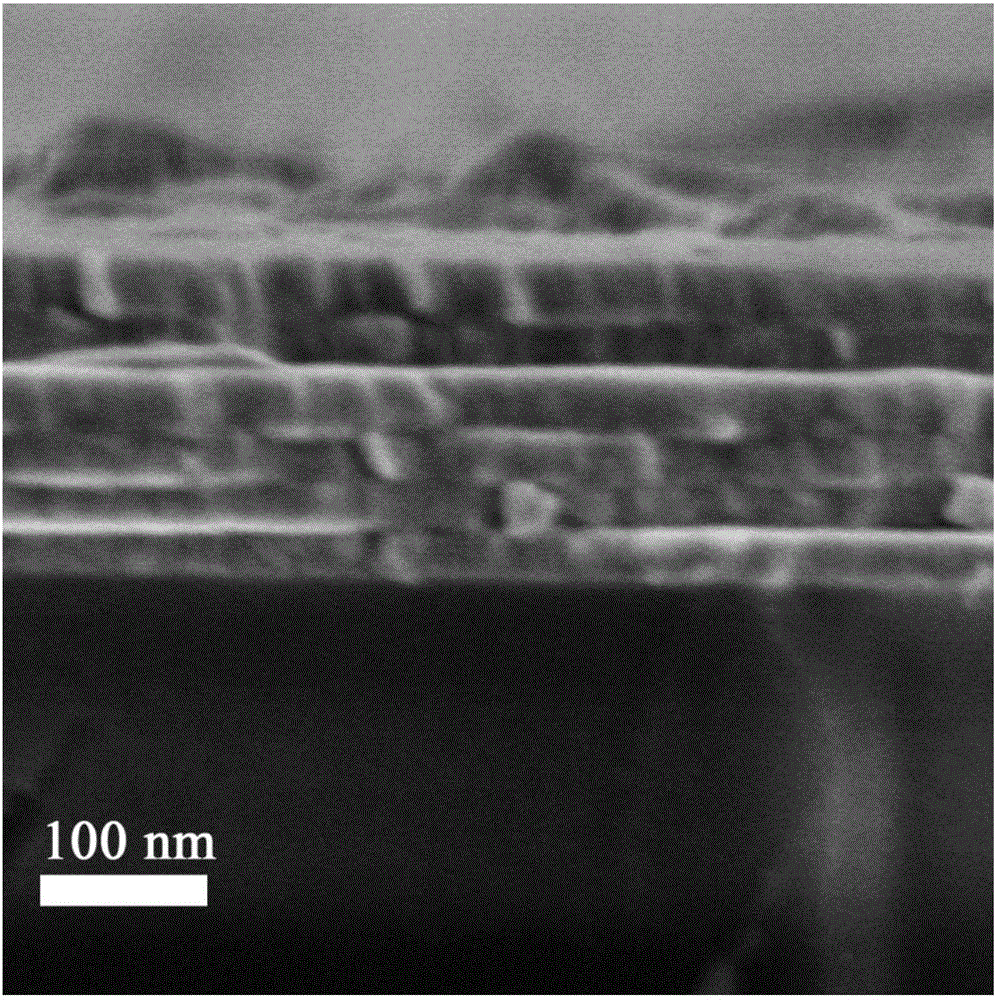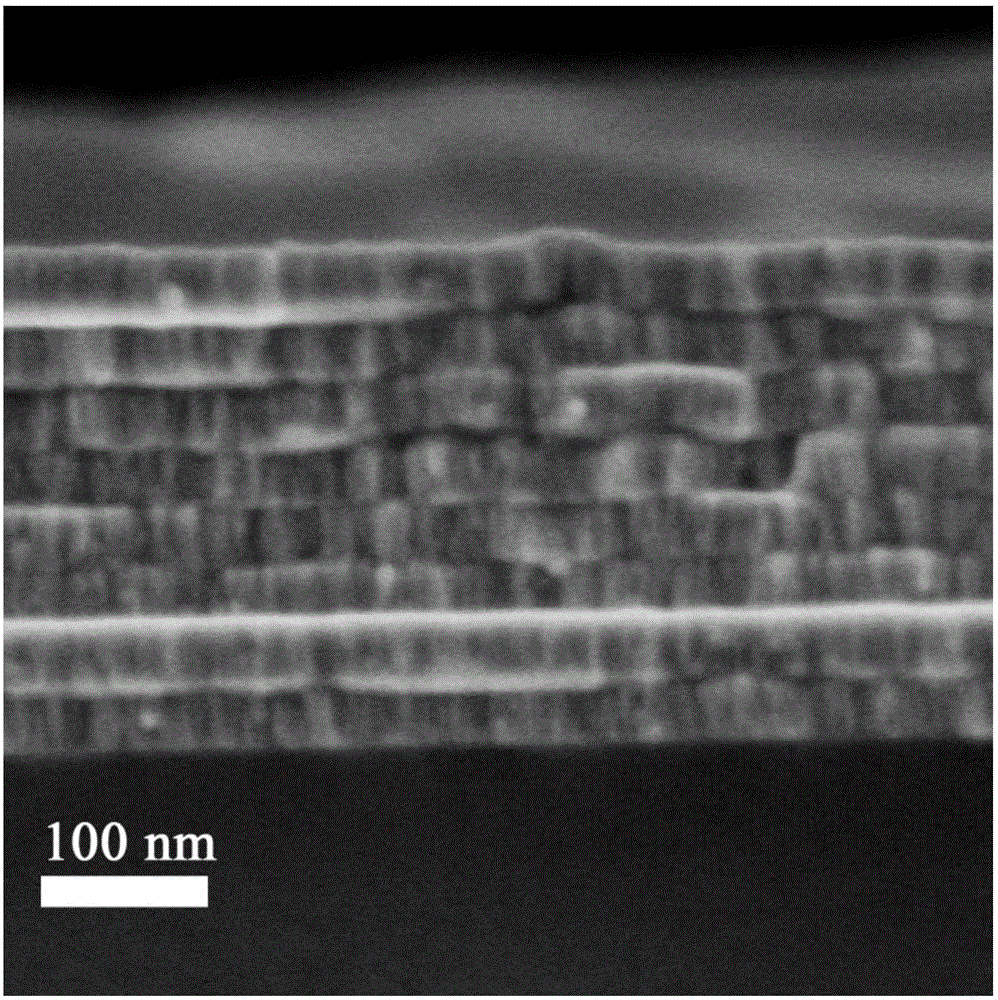Low-thermal-resistance radiation-resistant nano multilayer film material and preparation method thereof
A nano-multi-layer and thin-film material technology, applied in the field of nano-materials, can solve problems such as thermal performance degradation, achieve low interface contact thermal resistance, reduce thermal conductivity degradation, and excellent radiation resistance
- Summary
- Abstract
- Description
- Claims
- Application Information
AI Technical Summary
Problems solved by technology
Method used
Image
Examples
Embodiment 1
[0035] A low thermal resistance, radiation-resistant nano-multilayer film material, which is a multi-layer composite structure cross-stacked with metal tungsten nano-film and single-layer graphene; wherein, the thickness of the metal tungsten nano-film is 30nm, and the number of layers is 6 layers, and the number of layers of single-layer graphene is 5 layers.
[0036] The preparation method of the above-mentioned low thermal resistance, radiation-resistant nanometer multi-layer thin film material specifically comprises the following steps:
[0037] (1) Sonicate the 300nm silicon dioxide substrate with acetone, absolute ethanol, and deionized water for 10 minutes in sequence, then dry it with a nitrogen gun, and then use a magnetron sputtering system to deposit a layer of metal tungsten nano-film; wherein, the magnetron Sputtering parameters: sputtering voltage 150w, background vacuum lower than 10 -4 pa, the film-forming vacuum is 0.5pa, the argon gas flow is 20sccm, and the...
Embodiment 2
[0044] The differences between this embodiment and Embodiment 1 are: the thickness of each layer of metallic tungsten nano film is 40 nm; the magnetron sputtering time is 10 min.
[0045]Measure the low thermal resistance and radiation-resistant nano-multilayer film material obtained in this embodiment by photothermal method measurement technology, wherein the number of layers of metal tungsten nano-film is 6 layers, and the number of layers of single-layer graphene is 5 layers. The thermal resistance caused by adding the graphene layer is 17.92×10 -9 Km 2 W -1 . This means that the thermal resistance caused by the graphene interface is very small and hardly hinders the transfer of heat, and the material obtained in this embodiment shows excellent thermal conductivity.
Embodiment 3
[0047] The difference between this embodiment and Example 1 is: the thickness of each layer of metal tungsten nano film is 40nm; the magnetron sputtering time is 10min, so that the thickness of each layer of metal tungsten nano film is 40nm; step (4) is a cycle repeating step (2) and (3) 6 times; the obtained low thermal resistance, radiation-resistant nano-multilayer film material, wherein 8 layers of metal tungsten nano-film, 7 layers of single-layer graphene.
[0048] Measure the nano-multilayer film material with low thermal resistance and radiation resistance obtained in this embodiment by photothermal method measurement technology, wherein the number of layers of metal tungsten nano-film is 8 layers, and the number of layers of single-layer graphene is 7 layers. The thermal resistance caused by the graphene layer is 10.29×10 -9 Km 2 W -1 . This means that the thermal resistance caused by the graphene interface is very small and hardly hinders the transfer of heat, and...
PUM
| Property | Measurement | Unit |
|---|---|---|
| thickness | aaaaa | aaaaa |
| thickness | aaaaa | aaaaa |
| thickness | aaaaa | aaaaa |
Abstract
Description
Claims
Application Information
 Login to View More
Login to View More - R&D
- Intellectual Property
- Life Sciences
- Materials
- Tech Scout
- Unparalleled Data Quality
- Higher Quality Content
- 60% Fewer Hallucinations
Browse by: Latest US Patents, China's latest patents, Technical Efficacy Thesaurus, Application Domain, Technology Topic, Popular Technical Reports.
© 2025 PatSnap. All rights reserved.Legal|Privacy policy|Modern Slavery Act Transparency Statement|Sitemap|About US| Contact US: help@patsnap.com



